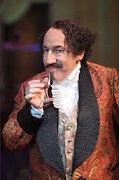- Egbert Souse
- Nov 6, 2008
-

|

In 1927, one of the great monuments in cinema, Napoleon vu par Abel Gance (Napoleon as seen by Abel Gance) premiered in France. Originally meant to be part one of a series of films about the life of Napoleone Bonaparte, the film ended up being the only part. Dogged by tepid audience reaction upon its original release, re-cuts, rights issues, and attempts at restoration... it's finally coming back in proper form.
Napoleon is best known for its kinetic cinematography, with loads of hand-held shots, rapid cutting, multiple exposures, and painterly compositions. It also had sequences in widescreen, using three side-by-side cameras to create a massive 4:1 panorama.
Rather than going into a bunch of history covered better elsewhere, I recommend reading Wikipedia's entry on the film.
Here is the press release for the new restoration:
quote:At the occasion of The Toute la mémoire du monde festival, Costa-Gavras, Chairman of La Cinémathèque française and Francis Ford Coppola (American Zoetrope) have officially declared, after six years groundwork, that restoration work is to begin on Abel Gance’s 1927 masterpiece, Napoleon.
The work will be supervised by Georges Mourier and supported by France’s National Centre for Cinema and the Moving Image (CNC).
According to french film historian Philippe Esnault, Napoleon is truly a wild tree towering above the tame gardens of French cinema. Over 90 years, the movie has constantly fascinated. Its creative energy is huge; its destiny unique and strange. Widely acclaimed when it was made, it fell into oblivion within twenty years. By the year 2000, twenty-two different versions had been made; five celluloid restorations undertaken. Nothing like it has ever been known.
Even in 1927, Napoleon was screened in two different versions. The first, four hours long, was premiered at the Paris Opera and included three “triptychs” or three-screen sequences. The second was nine and a half hours long. It was shown at the Apollo Theater, without “triptychs”. This latter version provided the basis for Abel Gance’s “definitive” version, running at around six and half hours. Then between 1927 and 1971, Abel Gance himself produced several new cuts. And in the meantime, from 1949 on, Cinémathèque founder Henri Langlois and Marie Epstein embarked on a long process of conservation and restoration. Their aim was to produce the most complete silent version possible. Several other restoration attempts ensued, within the constraints of the means and knowledge available at the time, including three Kevin Brownlow versions (1973, 1982 and 2000) and one by Bambi Ballard (1992).
By 2007 however, the situation had become confusing. Successive interventions over the years, with different objectives and applying different work methods had produced a confusing history and made it impossible to know which version might be considered original.
Accordingly, La Cinémathèque française, to which director Claude Lelouch had granted French rights to the film, commissioned film historian and director Georges Mourier to conduct a comprehensive audit of all the material available. Between 2008 and 2014, some thousand cans were inspected, in France and around the world. 400 of these cans had been untouched since 1971. No previous restoration had included them. At the same time, between 2002 and 2010, La Cinémathèque française classified and catalogued its huge Gance paper archive. That too had been unavailable to previous restorers. And it yielded a capital document, the Rosetta stone of the Napoleon saga: a running order for the Apollo version, complete with precise footage figures.
New documentary evidence and the Cinémathèque’s extensive stock audit have transformed the way we see Napoleon. We now know that the movie exists in the form of two distinct negatives, both original, reflecting two distinct projects. Every restoration since 1949 mined the Opera and Apollo versions indiscriminately, erasing the specific differences between the two projects. Today, after six years preliminary groundwork, La Cinémathèque française is ready to undertake the first ever digital restoration of this legendary film. Restoration work will take place at Paris’ historic Éclair film lab.
Francis Ford Coppola and Robert A. Harris, owners of the world rights to Abel Gance’s film, have agreed to partner for this venture.
In 1979, Kevin Brownlow’s reconstruction debuted at The Telluride Film Festival, with the help of Tom Luddy and Bill Pence, and the world was reintroduced to Abel Gance's masterpiece. Mr. Harris and Mr. Luddy with the blessing of Mr. Coppola, arranged a test screening of Napoleon at the Walker Art Center in Minneapolis, MN, in order to allow Carmine Coppola and Abel Gance time to discuss the task of creating a score for Napoleon.
On January 23, 1981, the first live show debuted at Radio City Music Hall. This was a historic event, as it was the first time a large full symphonic performance had been undertaken since the Silent Era. Francis Ford Coppola will adapt Carmine Coppola’s score in accordance with the new findings, in view of worldwide distribution.
France’s CNC has provided meaningful financial support to the project in order to launch this ambitious restoration. Nevertheless, this colossal project will only succeed with new financing. La Cinémathèque française launches in 2015 a vast campaign seeking additional sponsors, to allow the public to discover this masterpiece of worldwide cinema.
“Cinema”, according to Abel Gance, “is the music of light”. Restoring Napoleon in its original Apollo version, including the three-screen finale, will at last enable audiences to see a definitive six-and-a- half-hour version. They will at last see the film as the musical composition Abel Gance intended it to be in 1927. They will see the music of light.
Make a date for 2017. Discover a masterpiece such as it has not been seen for ninety years.

I feel that Napoleon is one of the most essential of essential films. Not just in its incredible technical merits, but a genuinely entertaining film, especially for its long runtime.
Here's the trailer for the screenings in Oakland, CA back in 2012. You can get an idea of the grandeur of the film easily.
https://www.youtube.com/watch?v=v1m5Q09eEqY
|
 #
?
Apr 5, 2015 16:14
#
?
Apr 5, 2015 16:14
|
|
- Adbot
-
ADBOT LOVES YOU
|

|
|
#
?
Apr 25, 2024 08:11
|
|
- Yaws
- Oct 23, 2013
-

|
God drat this is cool. Thanks for the heads up.
|
 #
?
Apr 6, 2015 00:42
#
?
Apr 6, 2015 00:42
|
|
- Discount Viscount
- Jul 9, 2010
-

FIND THE FISH!
|
I heard rumblings about this (or maybe just a special screening) a while ago after seeing La Roue on TCM, which is how I encountered Gance for the first time.
Everything you said about Napoleon puts it right in line with how I felt about La Roue. Long and melodramatic and utterly engaging.
With all the special event screenings like Oscar-nominee marathons and TCM's partnership with Fathom putting classics back on the big screen nowadays I can easily see this getting a somewhat wide theatrical release, too.
|
 #
?
Apr 6, 2015 07:11
#
?
Apr 6, 2015 07:11
|
|
- Egbert Souse
- Nov 6, 2008
-

|
I've seen both the 4-hour cut with Carmine Coppola's score and the 5 1/2 hour cut with Carl Davis' score. Both work beautifully as films. Davis opted to mix his original music with plenty of contemporary music from when the film takes place. The opening snow fight uses Mozart's first movement from his 25th symphony, the night of The Terror has Bach's Passagilia in D Minor, and one battle has Beethoven's seventh. Pretty much like Barry Lyndon's soundtrack and as effective.
|
 #
?
Apr 6, 2015 13:58
#
?
Apr 6, 2015 13:58
|
|
- CountFosco
- Jan 9, 2012
-

Welcome back to the Liturgigoon thread, friend.
|
I remember watching this on a small screen tv on video back in my college days. Even in that circumstance, it impressed. Hopefully it'll come to Boston.
I can only imagine being in the orchestra for a live performance of this. As a french horn player, I can only imagine how my lips would feel after four hours of playing.
|
 #
?
Apr 6, 2015 14:40
#
?
Apr 6, 2015 14:40
|
|
- Adbot
-
ADBOT LOVES YOU
|

|
|
#
?
Apr 25, 2024 08:11
|
|












